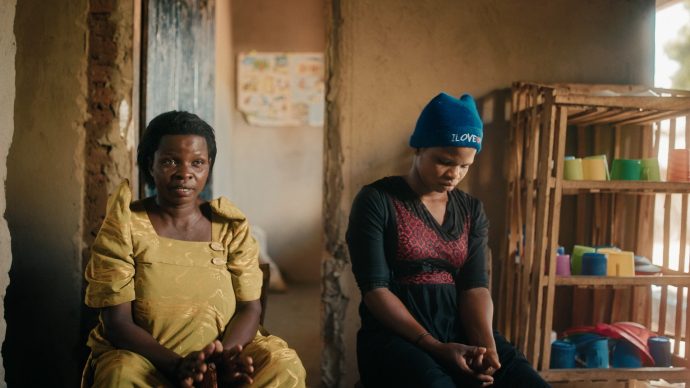Før kom den eneste strøm i den indiske landsby Dharnai fra en diesel-generator. Søndag lancerede Greenpeace og samarbejdspartnere et solcelle-system, der gør den lille landsby selvforsynende med energi, og projektet har potentiale til at hjælpe flere af de milliarder af fattige i verden uden strøm.
DHARNAI/JEHANABAD, Sunday 20 July 2014: Today Greenpeace India and partners BASIX and CEED launched a solar-powered micro-grid that could be a game-changing model for bringing reliable energy to millions around the world.
This happened at a ceremony attended by thousands in a small village in Bihar, India.
The ceremony, led by the oldest villager, formally kicked off a first-of-its kind in India 100 kW solar micro-grid.
Børn under solcellepaneller i den indiske landsby Dharnai, FOTO: Vivek M/Greenpeace.
It supplies around-the-clock electricity to more than 2,400 residents, 450 homes, and 50 commercial operations, including two schools and a health care facility.
Kan hjælpe de 1.3 milliarder uden elektricitet
“Today we have shown how the hundreds of millions of people around the world who are living without reliable electricity supplies can leap into the future by powering their communities with sustainable solar power,” said Kumi Naidoo, Greenpeace International Executive Director.
“This micro-grid is exactly the kind of innovation needed to bring electricity and its development benefits to the more than 1.3 billion people in the world who currently live without it. This is development at its best, bypassing the dirty and dangerous technologies of the 20th century and allowing people to own and control their own clean energy system.”
In India alone, more than 300 million people still wait for electricity. Worldwide the International Energy Agency says about 1.3 billion live without a reliable electricity supply.
Lille landsby er nu selvforsynende med energi
In Dharnai, Bihar, people have had to rely on expensive and health damaging kerosene lamps and individual diesel generators to provide light and power.
Now, they enjoy electric lighting, improved health care facilities and the safety of street lighting.
“We had tried everything in the book to get electricity for the last 30 years. But we haven’t seen a single speck of hope. While India was growing leaps and bounds, we were stuck here with kerosene lamps and expensive diesel generators,” said Kamal Kishore a resident of Dharnai.
“But now I can proudly say that Dharnai is a leader in innovation. We have established our identity as an energy-self-sufficient village and can compete with the country in its race to growth,” he added.

Indbyggere i landsbyen Dharnai ved lanceringen af projektet, FOTO: Vivek M/Greenpeace
The reliable, affordable and quick-to-install micro-grid in Dharnai provides a model for communities anywhere living without reliable electricity supplies.
This is a win-win technology, building more micro-grids would create thousands of new jobs, enhance energy independence, and spur economic development
For India, switching to wind and solar, and improving energy efficiency, could cut greenhouse gas emissions by 80% by 2050, and end the use of coal.
“Greenpeace stopper ikke energiprojekter – vi skaber dem”
“This village and this micro-grid project show that people anywhere can create their own energy system. The project shows the Indian government is wrong when it blames civil society groups, such as Greenpeace, for stopping energy projects; we create them,” said Samit Aich, Executive Director, Greenpeace India.
“This project signals to governments that they can replace out-dated energy systems that rely on nuclear, coal and other fossil fuels, with clean renewable energy,” he continued.
Greenpeace India developed the Dharnai micro-grid on the advice of a former Bihar Chief Minister to showcase a theoretical solution that could be replicated across Bihar.
Greenpeace now calls on the Bihar government to install renewable energy micro-grids for similar villages and to set up the appropriate policy framework.
The project also is consistent with the goal of the Indian government to significantly increase solar energy in India.
Quick facts on the micro-grid
– Provides electricity to more than 2,400 people, 450 households and 50 commercial establishments, including two schools, a training centre and a primary healthcare centre.
– 100 kW micro-grid: includes 70 kW for electricity generation for the community, and 30 kW for 10 solar-powered water-pumping systems of three horsepower each.
– Cost of the micro-grid: € 367,800 / $497,700 US
– Installation time: 3 months
– 280 solar panels, 224 batteries, 15 inverters; 10 x 3-horsepower water pumps
– cost of electricity (per kilowatt-hour (kWh) for:
18-Watt household installation: € 0.12 / $0.16 US
18-Watt commercial installation: € 0.16 / $0.22
30-Watt household installation: € 0.13 / $0.18
The micro-grid is operated in association with BASIX, a livelihood promotion institution as well as CEED, a network of NGO’s and think tank organisations in Bihar that support renewable energy development in the state.
Download en briefing om systemet her: http://www.greenpeace.org/india/en/publications/Dharnai-Live-Briefing-Paper
Se et factsheet om systemet her: http://www.greenpeace.org/india/en/publications/Dharnai-Live—Microgrid-Technical-Fact-Sheet














